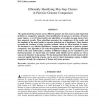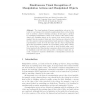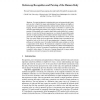115 search results - page 13 / 23 » Pairwise Features for Human Action Recognition |
ICPR
2008
IEEE
14 years 1 months ago
2008
IEEE
We propose a method for recognizing human actions in videos. Inspired from the recent bag-of-words approaches, we represent actions as documents consisting of words, where a word ...
JCB
2008
13 years 7 months ago
2008
The spatial clustering of genes across different genomes has been used to study important problems in comparative genomics, from identification of operons to detection of homologo...
ATAL
2008
Springer
13 years 9 months ago
2008
Springer
Recognizing team actions in the behavior of embodied agents has many practical applications and had seen significant progress in recent years. One approach with proven results is ...
ECCV
2008
Springer
14 years 9 months ago
2008
Springer
Abstract. The visual analysis of human manipulation actions is of interest for e.g. human-robot interaction applications where a robot learns how to perform a task by watching a hu...
EMMCVPR
2007
Springer
14 years 1 months ago
2007
Springer
Recognizing humans, estimating their pose and segmenting their body parts are key to high-level image understanding. Because humans are highly articulated, the range of deformation...



